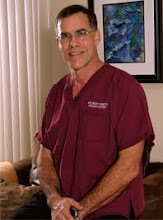 |
| Dr. Yoho climing El Capitan. No sticky foam here! |
Reston foam was commonly used by liposuction surgeons worldwide ten to fifteen years ago. Its utility involved pasting the loose skin just exactly where the surgeon wanted it to the muscle tissues after the liposuction procedure. The advantage to this is that the girdle and the patient’s movement were unable to distort the skin placement and produce strange wrinkles that would take many months to go away. The disadvantage of this was the possibility that the patient would become irritated from the adhesive, have an allergic reaction to the adhesive which would produce a red skin or a rash, or even tear the skin when they were taking the adhesive-backed foam off.
Our solution to these problems is as follows: We instruct our patients very carefully to watch their skin irritation level and come right back into the office if they’re having any problems or any pain. We tell them to soak in a bath at day four, and this dissolves the adhesive to some degree, and then at day five after the surgery, they can more easily remove the adhesive-backed foam. While this is not a comfortable process, we’ve found that the foam, particularly in the front of the abdomen (not so much the sides) generally produces a far smoother result with much less irritation, despite the aggravation of having to take the foam off.
That said, pigment problems, areas of skin irritation or even superficial loss, and some other problems occur with the foam. Despite this, use of the sticky foam is exceedingly helpful, particularly in large-volume liposuction cases.
Another alternative to the foam is if the responsible patient is able to massage the area from day one or day two after the surgery, they can keep the wrinkles from occurring. This usually has to be done, however, in a lying-down position because the patients have a tendency to feel faint when they take the garment off this early.


